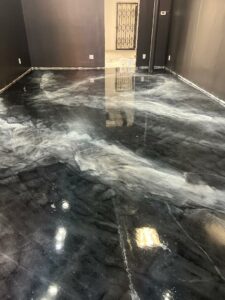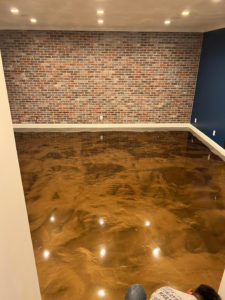Epoxy Floors Types & Styles
Epoxy floors are composed of two distinct parts mixed before application.
The two parts contain an epoxy resin combined with a hardener or co-reactant.
The formulation of epoxy coatings is done depending on the final product.

With proper formulation and application, epoxy coatings produce a hard finish that is also resistant to solvents and chemicals.
These coatings are commonly used on steel and concrete to make the surface resistant to water, acids, and alkalis.
The combination of the epoxy components used in the formulation determines the suitability of the coating for a particular environment.
One Part Concrete Paint versus Epoxy Coatings
Some people assume that epoxy coatings and paint refer to the same thing.
However, that is not true. Concrete paint is usually a latex acrylic product.
Most renowned paint manufacturers provide paint mixed with a small amount of epoxy.
When that is done, it is known as one-part concrete paint or one-part epoxy paint.
This gives the paint better durability and adhesion than ordinary acrylic paints.
However, the paint is not an epoxy product or an epoxy coating.
How to Prevent Hot Tire Pick-up
Epoxy FloorsAlso known as hot tire lift, hot tire pick-up refers to a situation where the floor coating peels up in areas where the vehicle tires rest.
Tires are manufactured using oily and waxy compounds.
You usually park your vehicle in the same spot if your cement floor is uncoated.
After a certain period, there can be residual buildup, which may lead to peeling or lifting.
Various factors, including inadequate floor preparation and poor quality epoxy, contribute to hot tire pick-up.
To prevent the situation, it is advisable to use high-quality products and adequate cleaning and practice of the floor.
Remove any signs of stain, dirt, wax, or oil. Additionally, have your concrete ground.
Grinding gives concrete floors an excellent preparation in readiness for epoxy coating.
You also need to undertake a water test, which will help you to establish whether your floor is profiled correctly.
A concrete floor should quickly absorb a few drops of water if adequately profiled.
Chemical Composition of Metallic Coatings
Metallic coatings provide a corrosion-resistant and durable layer wherever they have been applied.
When combined, paint and metal provide a surface with a reliable protective treatment, which is more durable when compared to the individual elements.
Some of the commonly used metallic coatings include chromium, nickel, cadmium, zinc, and aluminum.
Metallic epoxy flooring is one of the hottest trends in decorative concrete floors.
You can achieve a wide range of visual effects and colors with metallic flooring.
Others enable you to achieve a stunning 3D appearance, which produces an impression of ripples, swirling rivers, and craters of metallic-looking plasma.

Metallic epoxy also creates movement and depth in the floor, thus replicating molten metal.
If you have been considering metallic epoxy flooring for your surfaces, here is everything you need to know to determine whether it is viable.
What Is Metallic Epoxy?
This flooring material is obtained when 2-component epoxy solids combine with metallic pigments.
The result is a self-leveling epoxy coating, which is easy to manipulate to create or produce different visual effects.
Various solvents, like denatured alcohol, are applied to the floor.
These solvents diffuse and move the metallic pigments around in the epoxy.
This creates the look of a flowing river, as well as spots of fractured-looking molten metal sitting on the surface of the coating.
As you might have noticed, anyone cannot carry out this process.
You need to hire professional contractors who have specifically handled such projects successfully.
The application method used determines the result.
For example, some products can be worked with a leaf blower or an air nozzle, giving effects like rolling waves, puddling ripples, and moon craters. You can also create two-tone products when introducing a second color during the application.
Are They Durable?
Durability is one of the most important considerations when choosing a flooring material.
Looks can be deceiving, but these beautiful metallic flooring solutions are high-performance coatings that can last many years.
An epoxy primer should be installed when applying the first coat. The actual metallic epoxy coating is used during the second coating.
A third clear coat on the surface then follows this. Some contractors install the 4th coat if the top coat is polyurethane.
The result is a very thick coating because of the number of skins involved.
These metallic coatings are equally resistant to salts, oils, acids, chemicals, water, and wear, just like other high-performance epoxy flooring materials.
Their ability to reflect light is outstanding because of their glossy surface.
This results in considerable cost-savings in energy bills. Furthermore, metallic flooring is easy to maintain.
Similar to other epoxy coatings, these can also be slippery when wet, especially if you fail to apply an anti-slip additive on the final top coat.
Metallic Epoxy Installation
Metallic epoxy installation is similar to other multi-coat systems.
The only difference is manipulating the pigment used in the metallic coating or adding metallic solvents.
If you plan to install this floor coat, you will require at least two people, considering the time limitations involved during the steps.
Most of these coats are applied using a squeegee or a notched trowel.
It is then back-rolled using a 3/8-inch roller to produce a thicker film.
This process allows the metallic pigments to move throughout the proxy quickly.
Due to the thickness of the coat, a gallon of the mixture will only cover around 50 feet.
Therefore, one person should mix the extra batches while the other applies metallic epoxy.
It would be best to start manipulating the metallic coat 15 minutes after application.
The person mixing the additional batches will also do this.
This process is achieved by blowing air straight on the epoxy.
This moves it around, thus creating ripples, waves, or craters. As you do this, depression will form.
However, it levels itself after 10 minutes, resulting in the desired effect.
Certain Metallic Epoxy Floors
Certain metallic epoxy by-products require the addition of metallic solvents to the base coat as an alternative to manipulating it with air.
These are applied after the base coat, thus inducing molten metal puddles and giving the surface a river effect.
These require at least 20 minutes to set. When working with solvents, it is always advisable to use a sample first.
Since solvents take some time to react with the epoxy, you will get an estimated duration needed to produce the desired effect.
Bottom Line
You need to note that metallic epoxy flooring is quite cost-intensive.
However, the extra cost of materials will soon be forgotten once your floor is done.
The metallic epoxy coating should be among your top considerations if you want a flooring option with an exotic and beautiful showroom look.
Metallic Epoxy Floors vs Regular Epoxy Floors
| Feature | Metallic Epoxy | Regular Epoxy |
|---|---|---|
| Appearance | Shiny, with a 3D appearance that mimics natural stone or lava. | Solid colors with a glossy finish. |
| Application | More complex, requiring skilled application to achieve the desired effect. | Straighter forward, easier for DIY projects. |
| Cost | Generally more expensive due to the specialized materials and techniques. | More cost-effective, especially for larger areas. |
| Durability | Highly durable and resistant to wear, chemicals, and moisture. | Very durable but may not be as visually striking after heavy use. |
| Use Cases | Ideal for high-end residential or commercial spaces seeking a unique look. | Suited for garages, warehouses, and areas where functionality is key. |